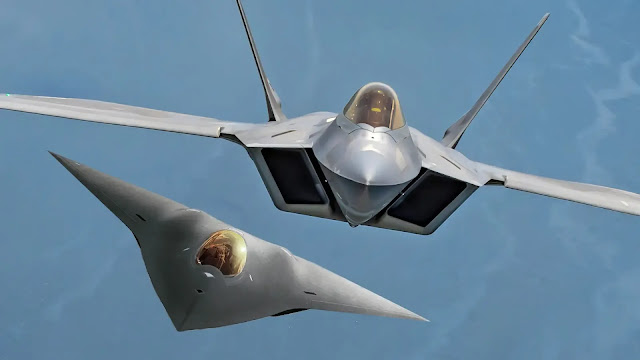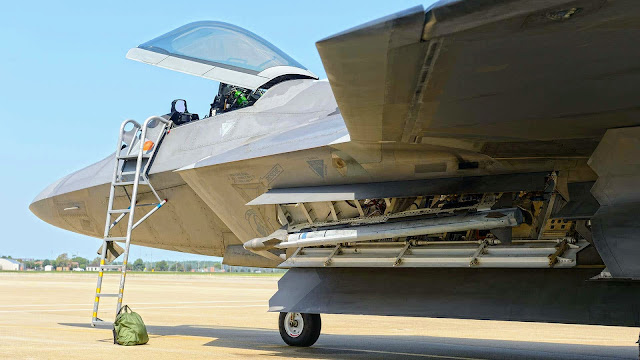
|
| F-22 program is adapting in order to preserve its potential well into the 2030s, when it will eventually be replaced by the Next Generation Air Dominance System (NGAD) |
- In point of fact, it has the potential to produce a Raptor that is significantly more robust, lethal, and genetically connected.
- However, future applications, in particular as integrated air defense systems (IADS), may require the sale of some radar escape capabilities in order to give the Raptor further improvements in both its ability to survive and to attack.
At Edwards Air Force Base, an F-22 Raptor belonging to the 411 Test and Evaluation Squadron is seen flying with envelopes that defy description dangling from its lower wings. It's the first time any of us have come across a Raptor with a mast quite like this one. This demonstrates how quickly the F-22 program is adapting in order to preserve its potential well into the 2030s, when it will eventually be replaced by the Next Generation Air Dominance (NGAD) System.
Is the F-22 Raptor Completely Upgraded?
Photographer James Ryder, who specializes in aviation photography, was the one who captured these breathtaking images of the Raptor in question (serial number 06-0132) during the middle of the day at the 42nd Air Force Base in Palmdale, California, which is used by @boreeder on Instagram. To put it another way, the F-22 in question was not cloaked in secrecy. Paparazzi are regulars at famous airports. SkunkWorks, the advanced projects division of Lockheed Martin that was responsible for the initial development of the Raptor, is also located at Plant 42.

|
| F-22 Raptor with Mirror skin |
In addition, the aircraft was covered with the typical test grades that are used in the environment of flight testing. It looks like repairs or scratches have been made to the welds and multiple panels just recently. In addition to that, this is a common occurrence that is used to evaluate the power of a raptor.
Despite the fact that F-22s typically fly domestic aircraft and sovereign missions with external fuel tanks, and despite the fact that we have seen them launch missiles at their submarine fixed points for testing, this is the first time that we have seen an F-22 with any type of propeller in the lower visible cover. Despite the fact that this is not a novel concept, which is something that we will discuss in a moment,
In addition to things that directly ignore the low visibility features of the F-22, such as attaching rocket trailers to rockets and adding large fuel tanks, adding anything will change the outer line of the mold, which requires a fine balance between reduced radiofrequency signature and major capacity improvements. For example, attaching rocket trailers to rockets. It was always something that was taken into consideration, but now that the F-22 is entering the second half of its life, there are some opportunities that might be better off "hidden." In point of fact, it has the potential to produce a Raptor that is significantly more robust, lethal, and genetically connected.
It is possible that this is the case with the mirror cover that we observed on the F-22; since then, other top-secret aircraft, such as the F-117 and the F-35, have flown with it. Even though skin treatment may make it more difficult for the aircraft to hide from some radars and may make it easier for the ball to see it with its naked eye, it may also make it possible to increase the distance at which infrared sensors can detect the aircraft. These sensors have evolved into a significant danger to all aircraft, but especially to the confidentiality of information on modern battlefields. Even if it turns out to be nothing more than speculation, it shows how difficult the choices are that need to be made in order to keep the American Super Fighter at the top of the food chain in aerial combat.
The F-22 Raptor's wings are modified to accommodate additional modules
It seems like a lot of these situations are very similar to one another. When the Raptor's wings are modified to accommodate additional modules, the radar signature should be carefully reshaped to increase in size without compromising its small size. This is especially important for certain radar aspects and radar bands. Because there is less potential for damage, the adverse effects can be mitigated.

|
| F-22 Raptor's wings are modified to accommodate additional modules |
However, future applications, in particular as integrated air defense systems (IADS), may require the sale of some radar escape capabilities in order to give the Raptor further improvements in both its ability to survive and to attack. conduit, which has the capability of destroying a covert aircraft's ability to avoid being discovered at closer ranges. This is especially true for low-visibility tactical aircraft like the F-22, which was designed several decades ago during a time when individual X-zone fire control radar was a major threat that needed to be prevented. and IADS make networking activities much simpler than they have ever been before.
Thanks to advances in computers, data links, and data fusion, as well as large leaps in sensor performance across all areas, this has changed dramatically. For example, AESA radars, which see smaller and more secret targets at greater distances and were mostly in the United States at the time of launching the F-22, are now proliferating around the world, and America's enemies have consulted their platforms largely.
This is a textbook example of bringing the state of the art from several decades ago up to date in order to deal with the challenges of modern warfare. The United States Air Force has communicated that it is interested in doing so with the F-22, and the service acknowledges a number of preferences for this jet.
These include, but are not limited to, the following, and others may be concealed somewhere within the classified sphere:
- Including the Thales Scorpion helmet-mounted display and weapon curing system in the integration
- A search-and-track sensor that operates in the infrared spectrum over long distances
- Combining manned and unmanned resources in a mission
- Automation with the assistance of the pilot
- A navigation system that is comparable to but not identical to GPS
- An exercise in the simulation of "red air" threats
- Methods for computing "optimized intercepts" through the use of algorithms
- Identifying potential dangers in the battlefield
- The identification and prevention of cyber intrusions
- The use of predictive maintenance technology
- Generation of Data Using Synthetic Methods
- Integration of multiple sensors
- Improved sensing
- Real-time debriefing
Taking that into consideration, what are these pods for? We do not know the answer for certain, but it is undeniably plausible to assume that this is the case.
The F-22 already possesses an Electronic Support Measures (ESM) system that is very capable and also has an Electronic Warfare (EW) capability
One of the first things that comes to mind about them is the fact that they are a new and advanced electronic warfare capability that can typically be bolted onto the F-22. The modules themselves are very much like the self-escort modules for electronic warfare that are used today. One example of this would be the popular 8222 series in ELTA. Obviously, this is just one illustration. Each system needs to be customized to work with the pre-existing mission systems of the F-22 and installed in modules that are difficult to spot using technology that conceals RF apertures.
In a normal situation, only one module is worn; however, the more robust system will enable the F-22 to carry out electronic attacks, both offensive and defensive, and even launch cyberattacks against itself, other Raptors flying with it, and other friendly aircraft in the vicinity. The Raptor already possesses an Electronic Support Measures (ESM) system that is very capable and also has an Electronic Warfare (EW) capability. The integrated AN/ALR-94 system in the F-22 is capable of locating and classifying potential danger emitters, and it also possesses some electronic warfare capabilities. As a result of the Raptors' ability to climb to altitudes of up to 65,000 feet, an upgraded version of the ESM or EW could benefit from having a tall boat. The Raptor will be able to provide an improved capability for electronic support measures (ESM) and electronic warfare (EW), which will also allow it to function more efficiently while providing support.
In addition, a very capable upgrade for electronic warfare may be worth the effort to sell some low-looking F-22s for the reasons that we have already mentioned. These reasons include the fact that we have discussed them previously. This will add an additional layer of defense for deep-air operations, which are where the Raptor was designed to fight from the beginning. If it is based on AESA, the electronic warfare module can also provide secondary communication and other sensor functions in addition to those capabilities. It is reasonable to assume that the AN-APG-77 AESA radar of the F-22 already possesses some functions of secondary electronic attack; consequently, its combination with other systems to improve situational awareness in the aircraft is a new system of electronic warfare that can upgrade extraordinary, powerful abilities that can go beyond self-protection.

